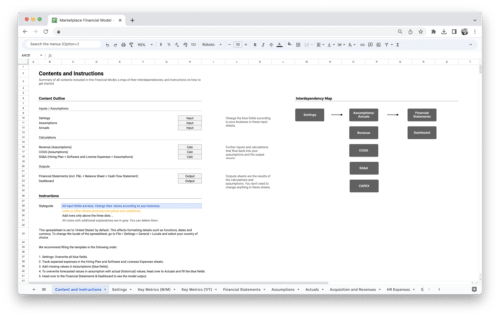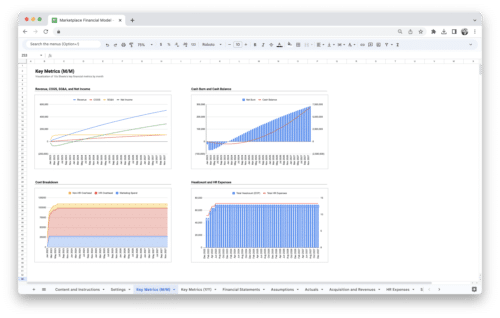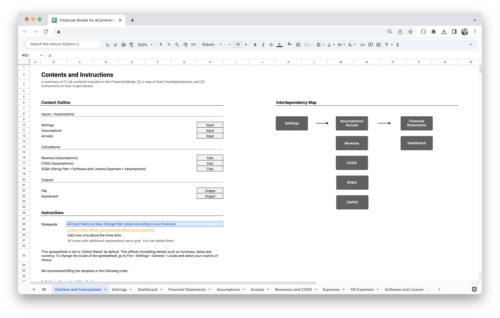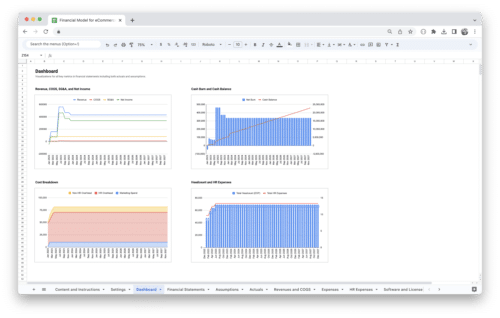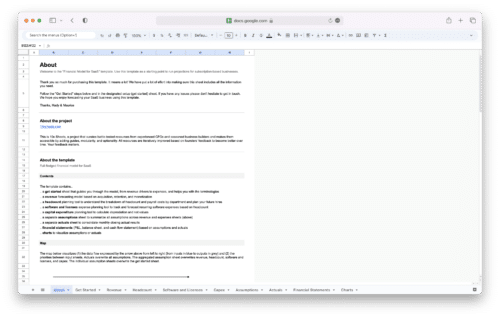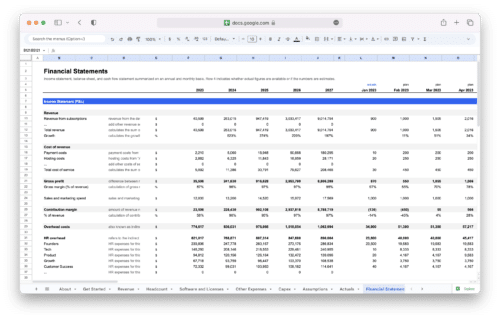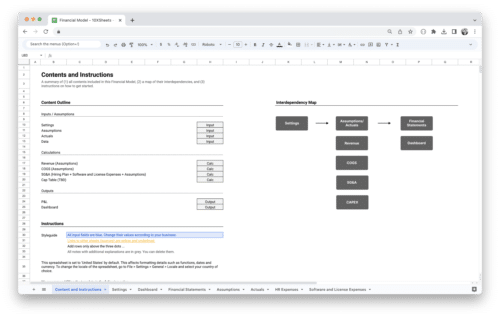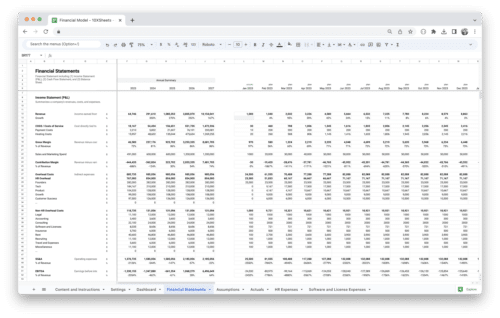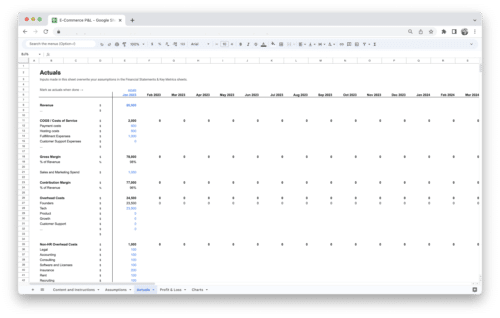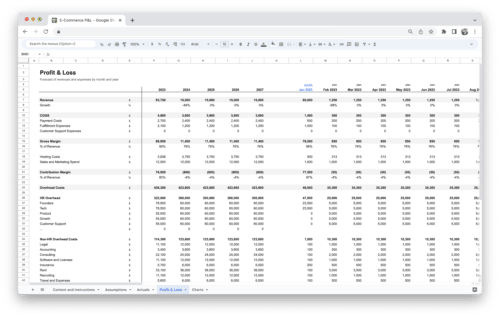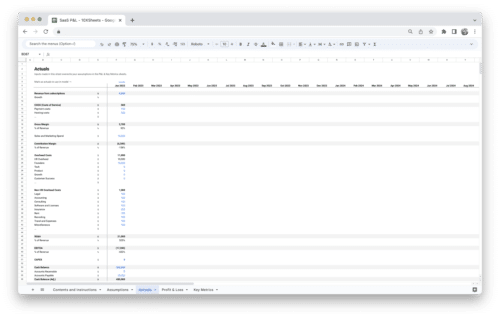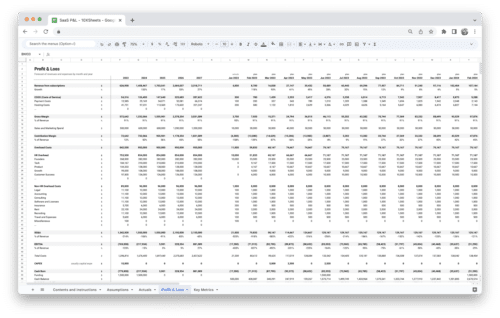
- What is Budget Variance Analysis?
- Key Budget Variance Analysis Concepts
- How to Conduct Budget Variance Analysis?
- Methods for Analyzing Variances
- Budget Variance Analysis Examples
- Budget Variance Analysis Tools and Techniques
- Common Causes of Budget Variance
- Addressing Budget Variance: Corrective Actions
- Budget Variance Analysis Best Practices
- Conclusion
Have you ever wondered why your actual financial results don’t always match up with what you expected? Budget variance analysis is the key to understanding these differences and making sure your business stays on track. Whether you’re dealing with unexpected costs, higher-than-expected revenue, or something in between, variance analysis helps you figure out what’s going on and how to fix it.
By comparing what you planned with what actually happened, you can identify areas that need attention and adjust your strategies accordingly. It’s a straightforward way to keep your finances in check, improve decision-making, and ensure that your business is heading in the right direction.
What is Budget Variance Analysis?
Budget variance analysis is the process of comparing a company’s budgeted financial performance against its actual performance to identify discrepancies, known as variances. The goal is to understand why certain numbers are different from what was originally planned or projected. Variances can be classified as favorable (when actual performance is better than expected) or unfavorable (when actual performance falls short of expectations). By calculating these differences, businesses can gain insights into how well they are meeting their financial goals and identify areas that require corrective actions.
Importance of Budget Variance Analysis
Budget variance analysis plays a pivotal role in keeping businesses on track financially. It not only helps identify areas where a business is overspending or underperforming, but it also provides crucial data that can guide adjustments to improve overall financial health. Through this analysis, businesses can better manage resources, control costs, and achieve long-term financial stability.
- Identifies potential financial issues early: Variance analysis highlights discrepancies between expected and actual performance, allowing businesses to detect problems before they escalate.
- Improves budgeting accuracy: By regularly comparing actual performance against budgeted figures, companies can refine their budgeting processes and make more accurate forecasts in the future.
- Promotes financial control and accountability: Variance analysis helps monitor expenses and revenues, ensuring that departments or teams adhere to the allocated budget and meet their financial objectives.
- Enhances decision-making: Variances provide insights into where changes are needed, which can be crucial for making informed, data-driven decisions regarding resource allocation, pricing strategies, and cost management.
- Supports continuous improvement: By regularly reviewing budget variances, businesses can identify trends, learn from past performance, and make adjustments to improve future outcomes.
How It Helps Businesses Monitor Financial Health
Budget variance analysis is essential for tracking a business’s financial health and ensuring it stays on target to meet its objectives. By comparing actual performance to budgeted figures, businesses can monitor how well they are adhering to their financial plans and whether they are on track to achieve profitability. The process of variance analysis provides valuable insights into various aspects of financial performance, such as revenue generation, cost control, and resource allocation.
Effective monitoring of financial health through variance analysis allows businesses to:
- Assess cash flow: It helps track whether cash inflows and outflows align with expectations, providing insight into whether the business is operating efficiently.
- Spot inefficiencies: Variance analysis reveals areas where expenses are higher than anticipated or revenue is lower than expected, highlighting inefficiencies or potential risks.
- Gauge financial stability: Regular analysis ensures that financial discrepancies are addressed quickly, helping maintain financial stability and preventing costly mistakes from snowballing into larger issues.
- Monitor profitability: By identifying cost overruns or revenue shortfalls early, businesses can take corrective actions to protect their margins and optimize profits.
Ultimately, the insights gained from budget variance analysis help businesses adjust their strategies and operations to ensure long-term success and financial security.
The Role of Variance Analysis in Strategic Decision-Making
Variance analysis plays a crucial role in strategic decision-making by providing the data necessary to make informed, proactive adjustments. By analyzing budget variances, businesses can not only address immediate issues but also plan for future growth. It enables managers and decision-makers to pinpoint areas that require attention, whether it’s increasing efficiency, adjusting revenue targets, or controlling costs.
Here’s how variance analysis contributes to strategic decisions:
- Refining business strategies: When actual performance doesn’t meet expectations, variance analysis provides the data needed to re-evaluate current strategies. For instance, a company may decide to adjust its pricing structure or improve its marketing efforts if revenues consistently fall short of budgeted targets.
- Optimizing resource allocation: By identifying areas where spending exceeds expectations or where underutilized resources exist, variance analysis helps businesses allocate their resources more effectively. This ensures that budgets are directed to areas that provide the greatest return on investment.
- Supporting risk management: Variance analysis allows businesses to assess external and internal risks that may affect financial performance. Understanding the reasons behind unfavorable variances helps businesses develop risk mitigation strategies to handle future uncertainties.
- Guiding long-term planning: Variance analysis provides essential data that can guide long-term planning and forecasting. By examining trends in variances, businesses can make more accurate predictions about future performance and develop strategies that align with their goals.
Key Budget Variance Analysis Concepts
Understanding key terms in budget variance analysis is crucial for effectively interpreting the results. These terms form the foundation of your analysis and help you identify what went right, what went wrong, and how to make the necessary adjustments to your financial plan.
Budget vs. Actuals: What They Represent
When we talk about a budget and actuals, we’re comparing what you planned for your finances with what actually happened. The budgeted figures represent your projections based on past data, assumptions, or strategic goals, while the actuals reflect the real financial outcomes once all transactions have been recorded.
The budgeted figures are typically created at the beginning of a fiscal period (e.g., a year or a quarter), taking into account your sales forecasts, anticipated expenses, and expected profits. They serve as a financial roadmap, guiding how much you intend to earn and spend. These projections are often based on historical data, market trends, and strategic priorities.
On the other hand, actuals are the results that occur after the period ends. These reflect the real revenue you earned and the expenses you incurred. The difference between the budget and actual performance is what leads to variances, which can reveal significant insights into business operations.
Variance: What it Is and How it Is Calculated
A variance is the difference between the budgeted (expected) amount and the actual (real) amount for a particular financial category, such as revenue, expenses, or profits. Variance analysis involves calculating these differences and then interpreting what they mean for the business.
The basic formula to calculate variance is:
Variance = Actual – Budgeted
A positive variance occurs when the actual result is greater than expected, and a negative variance occurs when the actual result falls short. It’s important to note that whether a variance is favorable or unfavorable depends on the context:
- If the actual revenue is higher than budgeted, it’s a favorable variance.
- If the actual expenses are higher than budgeted, it’s an unfavorable variance.
Understanding the variance is essential because it helps you identify whether you’re meeting your financial goals and where adjustments might be necessary.
Favorable vs. Unfavorable Variances
After calculating the variance, the next step is determining whether it’s favorable or unfavorable. This distinction is key to understanding whether the business is performing better or worse than expected.
- Favorable Variance: This occurs when actual performance exceeds expectations. For example, if your company expected to earn $100,000 in revenue but actually earned $120,000, this $20,000 difference would be a favorable variance. A favorable variance typically indicates better-than-expected business performance, whether it’s due to higher sales, lower costs, or a combination of both.
- Unfavorable Variance: An unfavorable variance happens when the actual performance falls short of the budgeted amounts. For instance, if your expenses were projected at $50,000 but ended up being $60,000, the $10,000 difference would be considered unfavorable. This variance often signals potential problems, such as overspending or underperformance in generating expected revenue.
The identification of favorable and unfavorable variances doesn’t always provide a complete picture. You’ll need to dig deeper into the reasons behind these variances to make the most informed decisions.
Common Types of Variances
There are various types of variances that can appear in a budget variance analysis, each providing insights into different aspects of financial performance. The most common ones are cost variance, revenue variance, volume variance, and price variance. Understanding these types will help you interpret the results more accurately.
- Cost Variance: This variance occurs when the actual cost of goods sold (COGS) or operating expenses differs from what was budgeted. It can happen due to changes in production costs, material prices, labor costs, or operational inefficiencies. A cost variance can be either favorable or unfavorable depending on whether the actual costs are lower or higher than expected. For example, if you budgeted $20,000 for raw materials and spent $18,000, the favorable variance might signal better cost management.
- Revenue Variance: This variance reflects the difference between the actual revenue earned and the revenue that was budgeted. A revenue variance can result from factors like changes in market conditions, customer demand, or pricing strategies. If you budgeted $150,000 in sales and achieved $130,000, the $20,000 difference would be an unfavorable revenue variance, which could indicate issues like lower-than-expected sales volume or pricing errors.
- Volume Variance: Volume variance occurs when the quantity of units sold or produced differs from what was expected. This variance directly impacts both revenue and cost. For instance, if you expected to sell 1,000 units of a product but only sold 800, the resulting volume variance could affect both your revenue (lower sales) and your cost structure (fixed costs that don’t vary with production).
- Price Variance: Price variance reflects the difference between the budgeted price of a product or service and the actual price received. Price variances can occur due to factors like changes in the market price, competitor pricing strategies, or internal decisions to offer discounts or premium prices. For example, if your budget assumed a product would sell for $10, but you were only able to sell it for $8 due to competitive pressures, you’d experience an unfavorable price variance.
Understanding these variances helps you pinpoint exactly where the financial discrepancies are coming from, whether it’s operational costs, sales performance, or pricing decisions. By analyzing these variances in detail, you can uncover trends, optimize your budgeting process, and make better decisions moving forward.
How to Conduct Budget Variance Analysis?
Conducting a thorough budget variance analysis involves a systematic approach that starts with creating a realistic budget and ends with making data-driven decisions to improve your financial performance. It’s essential to follow a structured process to ensure the analysis is accurate, insightful, and actionable. Here’s a breakdown of the key steps to successfully conduct a budget variance analysis.
1. Set Up an Effective Budget
The first step in the process is setting up an effective budget. A budget acts as your financial blueprint, and the accuracy of this initial step directly impacts the effectiveness of your variance analysis. Creating a good budget involves understanding your revenue sources, expenses, and strategic goals.
Start by gathering historical financial data, which serves as a benchmark for future projections. You also need to consider external factors like market conditions and economic trends. Your budget should not only reflect your past performance but also factor in your future growth expectations, planned investments, and any risks you foresee.
- Be realistic: Avoid overly optimistic or pessimistic assumptions. Setting achievable financial goals will give you a more accurate foundation for variance analysis.
- Use historical data: Past financial performance can provide valuable insights into future trends, helping you estimate both income and expenses more accurately.
- Incorporate flexibility: While it’s important to have a clear financial plan, ensure your budget can adapt to unforeseen circumstances, such as a sudden change in the market or a global crisis.
The budget should break down all income and expenses across categories such as sales, operational costs, marketing spend, and capital investments. It’s also helpful to set budget periods (monthly, quarterly, or annually) depending on the cycle that fits your business model. The clearer and more detailed the budget, the more useful your variance analysis will be.
2. Compare Budgeted Figures to Actual Performance
Once the budget is in place, the next step is to compare the budgeted figures against actual performance. This is the core of variance analysis: understanding where the numbers deviate from your projections.
To do this, gather the actual data for the same categories you included in your budget, such as total sales, expenses, and other key metrics. Depending on the tools you’re using, you can either manually input the data into spreadsheets or use accounting software that automatically compares budgeted and actual figures.
- Time frame consistency: Ensure that you are comparing data over the same time periods. For instance, if you’re analyzing monthly variances, make sure both budgeted and actual figures are from the same month.
- Highlight discrepancies: This step involves identifying where actual results differ from what was expected. These discrepancies, known as variances, are what you’ll analyze next.
You should examine both revenues and expenses. If revenues are higher than expected, you’ll want to understand why. Similarly, if expenses exceeded your budget, you’ll need to identify the specific areas where costs went over budget, such as materials, labor, or marketing.
3. Analyze Variances and Understanding Their Root Causes
After identifying the variances, the next step is to analyze them to determine their causes. Variances, whether favorable or unfavorable, don’t exist in a vacuum. They are often the result of specific actions, decisions, or external factors.
For each variance, ask questions to understand why the discrepancy occurred. Was it due to a mistake in forecasting or a change in market conditions? Were there unforeseen circumstances that impacted performance, such as unexpected regulatory changes or a competitor’s price drop?
For example, if your sales exceeded expectations, it might be due to a successful marketing campaign, a seasonal uptick, or increased demand. On the other hand, if your expenses were higher than planned, it could be because of rising raw material costs, inefficiencies in production, or poor planning.
- Root cause analysis: To fully understand why a variance occurred, ask yourself what specifically caused it. This deeper dive helps you pinpoint the true factors behind the discrepancy.
- Corrective action: If the cause of an unfavorable variance is something you can control (such as overspending on marketing or inefficiencies in production), you’ll need to develop corrective actions. If the variance is beyond your control (such as a natural disaster or supply chain disruptions), then you’ll focus on how to adapt your budget to future conditions.
Understanding the root causes of variances helps you take targeted actions, whether that’s adjusting your operations or refining your budget assumptions.
4. Categorize Variances (Fixed vs. Flexible Budgets)
Once variances are identified, it’s important to categorize them based on the type of budget you are working with—fixed or flexible. This categorization helps you determine the context of the variance and whether it’s indicative of a larger issue.
- Fixed Budget: A fixed budget doesn’t change, regardless of fluctuations in business activity. For example, if you planned to spend $10,000 on marketing, that amount remains the same regardless of actual sales or revenue performance. With a fixed budget, variances are more likely to occur if external factors (such as economic shifts or unexpected costs) are not accounted for in your initial planning.
- Flexible Budget: A flexible budget, on the other hand, adjusts based on changes in business activity, such as sales volume or production levels. This type of budget is more adaptable, allowing you to adjust the expected costs and revenues as actual business performance unfolds. With a flexible budget, if you sell more products than anticipated, your expenses might rise accordingly, but the budget allows for that variability.
Categorizing variances by the type of budget helps you understand whether the deviation is due to a fundamental issue with the budget assumptions or whether it’s a natural result of fluctuating business activity. For example, a volume variance might not be as concerning in a flexible budget, as it’s an expected outcome based on higher or lower sales.
By analyzing variances through the lens of fixed versus flexible budgets, you can develop more accurate financial models in the future, ensuring that your budgeting process becomes more dynamic and reflective of your business’s real-world performance.
Methods for Analyzing Variances
Analyzing variances effectively goes beyond simply identifying differences between budgeted and actual figures. To gain deeper insights and make informed decisions, you must apply different analytical methods. These methods help reveal patterns, trends, and root causes, allowing you to take corrective actions that improve financial performance. Let’s dive into some key techniques used to analyze variances in detail.
Horizontal Analysis: Tracking Trends Over Time
Horizontal analysis, also known as trend analysis, focuses on comparing financial data over multiple periods to spot patterns and assess how performance is evolving. This method is valuable for understanding long-term trends, spotting recurring variances, and identifying seasonal or cyclical changes in business operations.
In horizontal analysis, you track the same financial items across different time periods, such as monthly, quarterly, or annually, and calculate the percentage change over time. By doing this, you can determine whether variances are one-time occurrences or part of a more significant trend.
For example, let’s say your monthly revenue for the first quarter was:
- January: $100,000
- February: $120,000
- March: $130,000
To analyze this data horizontally, you would calculate the percentage change from January to February and from February to March.
The formula for horizontal analysis is:
Percentage Change = ((Current Period Amount – Previous Period Amount) / Previous Period Amount) * 100
- From January to February: ((120,000 – 100,000) / 100,000) * 100 = 20%
- From February to March: ((130,000 – 120,000) / 120,000) * 100 = 8.33%
This analysis reveals a 20% increase in revenue from January to February, followed by a smaller 8.33% increase from February to March. By observing these trends over a longer period, you can assess whether your business is growing consistently, or if specific months see fluctuations due to factors like seasonality or external market changes.
Horizontal analysis also allows you to identify anomalies. For instance, if one month shows a large unfavorable variance, it may be an isolated issue that doesn’t reflect your overall performance trajectory. This method helps you distinguish between outliers and sustained performance changes.
Vertical Analysis: Evaluating Proportionate Changes
Vertical analysis involves comparing individual financial line items to a common figure—usually total sales or total expenses—allowing you to assess the relative size of each item in the context of your overall financial performance. This method is particularly useful for understanding how each cost or revenue item contributes to your bottom line and tracking shifts in the proportion of those items over time.
To perform vertical analysis, each line item is expressed as a percentage of a base amount. For example, in an income statement, you could express each expense item as a percentage of total revenue. This helps you evaluate the efficiency of each component of your business operations.
For instance, if your total revenue for a given period is $500,000, and your total expenses are $300,000, you can express expenses as a percentage of revenue:
Expense Percentage = (Total Expenses / Total Revenue) * 100
- Expense Percentage = (300,000 / 500,000) * 100 = 60%
This means that 60% of your total revenue went toward expenses. Vertical analysis can help you track the proportion of expenses over time and identify areas where costs are rising or where cost-saving measures might be needed. It can also be used to compare different periods—whether one quarter’s expenses are in line with previous periods or if there’s a significant change.
If, in a different period, total expenses increased to $350,000 while revenue remained the same, the expense percentage would rise:
- Expense Percentage = (350,000 / 500,000) * 100 = 70%
This 10% increase in the proportion of expenses compared to revenue could indicate an efficiency problem, such as rising production costs or administrative expenses, that needs attention.
Vertical analysis works well for highlighting major shifts in your cost structure or revenue composition, and it’s particularly useful when comparing different-sized businesses or periods where total revenue may change significantly.
The Role of Standard Costing in Variance Analysis
Standard costing is a critical tool in variance analysis, as it helps businesses set predetermined costs for goods or services, against which actual costs can be compared. Standard costs are typically derived from historical data, industry averages, and expectations based on specific production or operational processes. These predetermined costs help provide a benchmark for financial performance and serve as the basis for variance calculations.
In variance analysis, cost variances are computed by comparing the standard costs (what you expected to pay) with the actual costs incurred (what you actually paid). This allows businesses to identify where and why discrepancies occur, especially in terms of labor, materials, and overheads.
For instance, if your company manufactures widgets, the standard cost for producing one widget might be $5, which includes $3 for materials and $2 for labor. If you produce 1,000 widgets and the actual cost of materials is $3.50 per unit and labor costs are $2.20 per unit, you can calculate the variances for both materials and labor:
- Material Variance: (Actual Material Cost – Standard Material Cost) * Number of Units = ($3.50 – $3.00) * 1,000 = $500 unfavorable
- Labor Variance: (Actual Labor Cost – Standard Labor Cost) * Number of Units = ($2.20 – $2.00) * 1,000 = $200 unfavorable
Standard costing is particularly useful in industries where mass production is common, and costs are predictable. By comparing actual costs against these standards, businesses can quickly identify where they are overspending and investigate the reasons—whether it’s due to inefficiencies, wastage, or fluctuations in raw material prices.
Using standard costing in variance analysis can help you improve cost control, identify potential savings, and set more accurate future budgets.
Comparing Actual Performance Against Industry Benchmarks
While comparing actual performance to budgeted figures provides valuable insights, comparing your performance to industry benchmarks can give you a broader perspective on how well your business is doing relative to others in your sector. Industry benchmarks offer a standard set of financial metrics that are typical within your specific market, allowing you to gauge your performance against competitors or industry averages.
These benchmarks could be related to revenue, profit margins, cost ratios, or any other financial metric relevant to your business. By comparing your actual performance against these benchmarks, you can quickly identify areas where you may be underperforming or outperforming industry norms.
For example, if your business has a gross profit margin of 40% but the industry average is 50%, it indicates that you may be facing inefficiencies or higher costs than your competitors. Conversely, if your margin is higher than average, it could signal that your pricing strategy or cost control measures are more effective.
Benchmarking is also essential for identifying market trends. If you’re seeing a consistent unfavorable variance in your revenue growth but industry-wide data shows positive growth, this could indicate that there are internal factors limiting your performance, such as ineffective marketing or operational inefficiencies.
Industry comparisons are most effective when using up-to-date and relevant data. Many industries have annual reports or databases that provide key performance indicators (KPIs) and financial ratios for companies within that sector, making benchmarking easier.
By comparing your actual performance to industry benchmarks, you can make better strategic decisions, whether that involves adjusting pricing, improving efficiency, or adopting best practices from market leaders.
Budget Variance Analysis Examples
Budget variance analysis can be a powerful tool when applied to real-world situations. To fully grasp how variances affect business performance, it’s helpful to look at specific examples. These examples illustrate how variances occur and how they can be interpreted to drive better financial decisions. Whether you’re dealing with sales, expenses, or production costs, understanding the examples below will give you a clearer picture of how variance analysis works in practice.
Example 1: Sales Revenue Variance
Imagine you run a retail store that projected $100,000 in sales for the month of January, but the actual sales came in at $85,000. The variance between the budgeted and actual sales is:
Variance = Actual Sales – Budgeted Sales
Variance = $85,000 – $100,000
Variance = -$15,000 (Unfavorable)
In this case, the variance is unfavorable because actual sales were lower than expected. The next step would be to analyze the cause of this shortfall. Did a competitor launch a new product, causing a decline in your sales? Or was there a drop in customer traffic due to weather conditions or an economic downturn? Identifying the cause of the variance helps you understand whether it was a one-time issue or part of a larger trend that needs addressing.
Example 2: Production Cost Variance
Let’s say your company manufactures widgets, and your budgeted cost to produce 10,000 units in January was $50,000, which includes both labor and material costs. However, after producing the widgets, you find that the actual production cost was $55,000.
Variance = Actual Production Cost – Budgeted Production Cost
Variance = $55,000 – $50,000
Variance = $5,000 (Unfavorable)
The unfavorable variance here means that the production process exceeded expectations. This could be due to higher material costs, overtime pay for workers, or inefficiencies in the production line. To resolve this, you would need to investigate whether material costs increased unexpectedly or whether production inefficiencies, like machinery breakdowns or labor shortages, were the culprit.
Example 3: Marketing Expenses Variance
A company might budget $20,000 for marketing expenses in Q1 to promote a new product. By the end of the quarter, however, the actual marketing expenses totaled $22,500. The variance would be calculated as:
Variance = Actual Marketing Expenses – Budgeted Marketing Expenses
Variance = $22,500 – $20,000
Variance = $2,500 (Unfavorable)
This unfavorable variance suggests that the marketing department exceeded its budget. The next step is to assess why this occurred. Did the company spend more on digital ads due to unexpected demand? Were there additional expenses related to promotional events or unforeseen agency costs? Understanding these details allows you to adjust future marketing budgets or reallocate resources to better manage expenses.
Example 4: Labor Cost Variance
Imagine your company projected that labor costs for a project would be $30,000 for the month of February. However, the actual labor costs came in at $28,000, resulting in a favorable variance.
Variance = Budgeted Labor Costs – Actual Labor Costs
Variance = $30,000 – $28,000
Variance = $2,000 (Favorable)
In this case, the variance is favorable because the actual labor costs were lower than expected. This could be due to improved worker productivity, fewer overtime hours, or a temporary reduction in workforce. It’s important to recognize that while a favorable variance is positive, it should still be assessed to determine if the cost savings are sustainable. For example, if the reduction in labor costs resulted in less work being done or delays in the project timeline, the savings may not be as beneficial in the long run.
Example 5: Fixed vs. Flexible Budget Variance
A software company might use a fixed budget for salaries and rent expenses, which are predictable and do not change with business activity. The company might budget $50,000 for salaries and $10,000 for rent, regardless of whether the business is growing or shrinking. However, in a flexible budget, these expenses would be adjusted based on actual sales or production levels.
If the company’s actual sales for the month were lower than expected, resulting in a lower volume of work, the flexible budget would adjust for that and show lower expenses. But if the company stuck to the fixed budget, the actual expenses would exceed the revised flexible budget, leading to unfavorable variances. For instance, if actual salaries stayed the same but revenue dropped, the company would be left with higher costs per unit of output, highlighting the importance of flexibility in managing costs.
These examples demonstrate how budget variance analysis works in various business areas, from sales and production to marketing and labor costs. By regularly performing variance analysis, you can identify areas that need improvement, make adjustments, and ensure that your business stays on course financially. Whether you’re working with favorable or unfavorable variances, the key is to investigate the underlying causes and take appropriate actions to maintain financial health.
Budget Variance Analysis Tools and Techniques
To conduct a thorough and effective budget variance analysis, it’s essential to leverage the right tools and techniques. Whether you’re using sophisticated software or basic spreadsheet models, these tools will help you automate calculations, track your performance, and present your findings in a clear and actionable way. Below, we’ll explore some of the most common tools and techniques that can enhance your budget variance analysis process.
Software Tools and Spreadsheet Models
Using software tools and spreadsheet models can significantly streamline the process of budget variance analysis, making it easier to track and compare actuals against budgeted figures. While larger companies may rely on complex accounting systems, even small businesses can benefit from using basic tools like spreadsheets.
Spreadsheets, such as Microsoft Excel or Google Sheets, are the go-to option for most businesses. These tools provide flexibility, ease of use, and accessibility, especially for businesses with smaller budgets or teams. You can create customized templates that suit your unique budgeting needs and simplify variance calculations.
A budget variance analysis spreadsheet template typically includes the following components:
- Budgeted amounts: These are the figures you expect to achieve (based on prior periods or business goals).
- Actual amounts: These are the real financial numbers you’ve achieved, updated regularly.
- Variance: This column calculates the difference between the actual and budgeted figures.
- Variance analysis: A section to categorize variances as favorable or unfavorable, with additional space for notes or further analysis on the causes of variances.
Many templates come pre-built with formulas for variance calculations, which saves you time. For instance, you could use a formula like:
Variance = Actual Amount – Budgeted Amount
This simple formula can be adapted for any line item, whether it’s for sales revenue, expenses, or any other financial metric you’re tracking. If you’re unfamiliar with building these templates, many pre-built templates are available online, providing a foundation that can be easily modified to fit your needs.
In addition to spreadsheets, budgeting and forecasting software such as QuickBooks, Xero, and Microsoft Power BI can help you automate variance analysis with built-in reports and dashboards. These tools offer more sophisticated analysis and can handle larger datasets, saving time and reducing the potential for human error.
For more advanced variance analysis, financial management software like NetSuite or Adaptive Insights can integrate directly with your accounting system and automatically track variances, making the process even more seamless.
Key Performance Indicators (KPIs) to Monitor Variances
Key performance indicators (KPIs) are essential for measuring how well your business is performing against your budgeted goals. These metrics help you monitor variances in real time and can guide your decision-making process. Here are some top KPIs you should track when performing a budget variance analysis:
- Gross Profit Margin: This KPI shows the percentage of revenue that exceeds the cost of goods sold (COGS). It’s a key indicator of your business’s efficiency in production and service delivery.
Gross Profit Margin = (Revenue – Cost of Goods Sold) / Revenue * 100 - Operating Profit Margin: This metric indicates the percentage of profit made from core operations after accounting for operating expenses. It provides insight into how well your business is controlling its costs.
Operating Profit Margin = Operating Income / Revenue * 100 - Net Profit Margin: This measures the overall profitability of the business, showing the percentage of revenue that remains as profit after all expenses (including taxes and interest).
Net Profit Margin = Net Income / Revenue * 100 - Variance to Budget (Revenue): This KPI calculates the difference between actual and budgeted revenue, which helps determine if your revenue projections were too high or low.
Revenue Variance = Actual Revenue – Budgeted Revenue - Cost Variance (Expense): This KPI measures how your actual expenses compare to your budgeted expenses. It’s essential for identifying areas where you’ve overspent or where you’ve been able to save money.
Cost Variance = Actual Expenses – Budgeted Expenses - Sales Growth Rate: This KPI tracks the percentage change in sales over a specific period, allowing you to measure the effectiveness of your sales strategy.
Sales Growth Rate = (Current Period Sales – Previous Period Sales) / Previous Period Sales * 100 - Return on Investment (ROI): ROI is critical for measuring the financial return on investments made in various business activities, such as marketing or capital expenditures.
ROI = (Net Profit / Investment Cost) * 100
By tracking these KPIs, you can identify areas where variances are either favorable or unfavorable. It also helps to understand which specific parts of your business need more focus or improvement.
Visual Aids Like Charts and Graphs for Effective Variance Presentation
Presenting budget variance data in a visually appealing and understandable format is critical for communicating your findings to stakeholders. Visual aids such as charts and graphs help translate raw numbers into digestible insights, making it easier to identify trends, patterns, and areas that need attention.
Common visual aids for budget variance analysis include:
- Bar Charts: These are great for comparing budgeted vs. actual figures side by side. You can use a bar chart to show variances across multiple categories or periods, such as comparing monthly revenue performance.
- Line Graphs: Line graphs are ideal for tracking performance over time. They show the trajectory of actual vs. budgeted values and are helpful for visualizing trends or identifying whether variances are consistent.
- Pie Charts: Pie charts can illustrate the proportion of expenses or revenue that each category contributes to the total. They’re especially useful for analyzing cost structures and understanding the relative size of different expense items.
- Waterfall Charts: A waterfall chart is useful for showing how an initial budget amount is affected by various favorable or unfavorable variances. It’s a great tool for tracking how each factor contributes to the final outcome.
- Heatmaps: These are often used for comparing large datasets. For example, you can use a heatmap to display variances across multiple departments or cost centers, highlighting areas that require immediate attention.
Using these visual aids allows for a quick, intuitive understanding of where variances occur and their significance. This helps stakeholders—whether they’re department heads or external investors—see at a glance whether the business is on track or if corrective actions are needed.
By incorporating these tools and techniques into your budget variance analysis process, you can gain deeper insights into your business’s financial performance, identify inefficiencies, and make informed decisions to drive future success.
Common Causes of Budget Variance
Budget variance analysis helps identify where actual performance deviates from expectations, but understanding the underlying causes of these variances is key to managing your finances effectively. Variances can arise from a variety of factors, both internal and external to your business. By identifying the root causes of these discrepancies, you can take targeted actions to improve performance or adjust your future budget assumptions. Below, we explore some of the most common causes of budget variance and how they can impact your business.
Internal Factors: Operational Inefficiencies, Labor Costs, Production Errors
Internal factors are those that arise from within your organization, often as a result of how you manage operations, allocate resources, or carry out daily activities. These factors are typically within your control, which makes them a prime area to target for improvement.
Operational inefficiencies can have a significant impact on your budget variances. These inefficiencies might involve delays in production, suboptimal workflows, or redundant processes that increase costs. For example, if your team is spending more time than expected on certain tasks due to outdated tools or disorganized workflows, the additional labor costs will create an unfavorable variance. Alternatively, a lack of automation or streamlined processes could lead to slower production times, affecting both cost and output.
Labor costs are another common internal factor that can cause budget variances. Labor is often one of the largest expenses for a business, so even small fluctuations in staffing levels, wages, or productivity can lead to significant variances. If you experience higher-than-expected turnover or if temporary workers are needed to meet demand, your labor costs may exceed budget projections. On the other hand, if productivity increases due to employee efficiency or a reduction in overtime, this could lead to favorable variances in labor costs.
Production errors are another internal factor that can cause variances. Errors during the manufacturing process or in the delivery of services can lead to unexpected costs. For example, defective products that need to be reworked or replaced add unplanned expenses, and poor quality control could lead to higher return rates or customer dissatisfaction. These issues directly impact both your operational costs and your ability to meet revenue expectations.
Addressing internal factors like inefficiencies, labor mismanagement, and production errors requires focusing on improving operational practices, optimizing resources, and investing in employee training and process improvements. By regularly assessing internal operations and making adjustments, you can better control variances in the future.
External Factors: Market Changes, Economic Conditions, Regulatory Shifts
External factors are those beyond your control but can still significantly influence your financial performance and contribute to budget variances. While you can’t directly manage these variables, being aware of them and planning for possible scenarios will help you make more informed decisions when setting budgets.
Market changes are one of the most significant external factors that can cause budget variances. Changes in customer preferences, shifts in demand for products or services, or the emergence of new competitors can all impact your business’s ability to achieve budgeted revenues. For example, if a competitor lowers their prices, it may force you to adjust your pricing strategy, potentially leading to lower-than-expected revenues. Similarly, if there is a sudden change in consumer behavior or preferences, demand for your products could either rise or fall unexpectedly, causing variances in revenue.
Economic conditions also play a major role in budget variances. Economic cycles, such as recessions or booms, directly affect consumer spending power and business investments. In a downturn, consumer spending may decrease, leading to lower sales than expected, while an economic boom might drive more demand for your products or services. Fluctuations in inflation rates, interest rates, and unemployment rates also influence both your costs and revenue streams, impacting how closely actual performance aligns with your budget.
Regulatory shifts are another external factor that can create variances. Changes in laws, tax regulations, labor laws, or environmental standards can impose new costs or alter business operations. For instance, a sudden increase in taxes or a new environmental regulation could require you to invest in compliance measures, thus increasing operational costs unexpectedly. Similarly, changes in import/export tariffs or trade restrictions could increase supply costs if you rely on international vendors.
Although you can’t control external factors, staying updated on market trends, economic conditions, and regulatory changes can help you adjust your budgets proactively. Being flexible and adapting to changes quickly will help mitigate the impact of these factors on your financial performance.
Identifying Non-Controllable vs. Controllable Variances
When analyzing budget variances, it’s essential to distinguish between controllable and non-controllable variances. Understanding which variances fall within your control and which do not allows you to focus your efforts on areas where you can make improvements and adjust expectations for factors beyond your control.
Controllable variances are those that arise due to decisions or actions that can be influenced by management. These variances are often the result of internal operational issues, such as overspending on marketing, poor inventory management, or misallocating resources. For example, if you overspend on marketing or employee salaries due to poor planning or inefficiencies, this would be considered a controllable unfavorable variance. Similarly, underestimating production costs or failing to optimize labor can lead to higher-than-expected expenses, which are within your ability to address.
To manage controllable variances, you can take corrective actions such as improving forecasting accuracy, streamlining operations, reducing waste, and ensuring better budget alignment with actual performance. Regularly reviewing budgets and performance metrics helps ensure that deviations from expectations are identified quickly and addressed promptly.
On the other hand, non-controllable variances are those caused by factors outside your organization’s influence. These include external factors like market changes, economic conditions, and regulatory shifts, as discussed earlier. For example, a sudden spike in material costs due to global supply chain disruptions is a non-controllable variance. Similarly, a downturn in the economy that leads to reduced consumer spending is outside your control.
While you can’t control non-controllable variances, you can manage the impact of these fluctuations by incorporating contingency plans into your budget. This might include setting aside a reserve fund for unexpected economic changes or adjusting your revenue projections to account for potential market fluctuations. Understanding which factors you can control and which ones you can’t helps you focus on areas where you can improve efficiency while preparing for external uncertainties.
By recognizing the causes of budget variances and classifying them as controllable or non-controllable, you can better strategize on how to address the issues that affect your bottom line. Whether it’s optimizing internal processes or preparing for market shifts, a clear understanding of these causes ensures that your variance analysis is both actionable and insightful.
Addressing Budget Variance: Corrective Actions
When variances occur in your budget—whether they are favorable or unfavorable—the next step is to address them with corrective actions. Taking the right steps to adjust course ensures that your business stays on track toward its financial goals. Depending on the cause and type of variance, different strategies will be needed. Addressing budget variances effectively is all about recognizing the problem, understanding its root cause, and implementing changes that bring performance back in line with expectations.
- Analyze the root cause of the variance: Begin by identifying why the variance occurred. Was it due to an internal issue such as inefficiencies, or did external factors like market changes or economic conditions play a role?
- Adjust future forecasts: If variances are due to external factors, adjust your future budgets and forecasts to reflect these new realities. For example, if costs of materials have increased due to supply chain issues, update your cost projections accordingly.
- Revise budget allocations: For controllable variances, revisit your cost allocations. If one area is overspending (e.g., marketing, operations), consider reallocating funds to ensure better alignment with strategic priorities.
- Implement cost-saving measures: If overspending is a significant cause of unfavorable variances, identify areas where cost reductions can be made. This might include renegotiating supplier contracts, reducing overhead costs, or cutting unnecessary expenses.
- Improve efficiency: If inefficiencies in production, labor, or other areas contributed to the variance, focus on process improvements or employee training to enhance productivity and reduce costs.
- Monitor performance more closely: Increase the frequency of variance reviews. By assessing financial performance more often, you can catch issues early and make quicker adjustments.
- Communicate with stakeholders: Keep everyone in the loop. If variances significantly impact your business’s financial health, inform relevant stakeholders and involve them in the decision-making process for corrective actions.
Budget Variance Analysis Best Practices
To make budget variance analysis a valuable tool for your business, you need to establish a consistent, methodical approach. Applying best practices ensures that your analysis remains accurate, insightful, and actionable, ultimately leading to better financial management and decision-making.
- Review budgets regularly: Conduct variance analysis on a monthly or quarterly basis to stay on top of your business’s financial performance and quickly identify any discrepancies.
- Focus on both favorable and unfavorable variances: Don’t just look at negative variances. Investigate favorable variances to understand why performance exceeded expectations and whether that success can be replicated.
- Dig deep into the numbers: Look beyond surface-level variances. Try to understand the root causes of discrepancies, especially when dealing with significant differences. This will help you pinpoint actionable solutions.
- Involve relevant departments: Collaboration is key. When variances arise, involve department heads to understand their perspectives and get their insights into the causes and solutions.
- Use technology to streamline the process: Leverage software and tools that can automate the tracking and reporting of variances, making the process faster and more accurate.
- Track key performance indicators (KPIs): Use KPIs that are closely tied to your business goals to assess performance. Tracking these metrics will help you keep variances in context and identify which areas need attention.
- Adjust for external factors: Understand that external conditions like market changes, regulatory shifts, and economic downturns can create variances that are outside your control. Factor these into future budgets and expectations.
- Use variances as a learning tool: View variances as opportunities for improvement. Use them to refine your forecasting and budgeting process, ensuring more accuracy in future periods.
- Maintain flexibility: Budgets should be dynamic. Regularly adjust them based on actual performance and changing business conditions to ensure they remain aligned with your goals.
- Document and track corrective actions: Keep a record of actions taken to address variances and monitor their effectiveness. This will help you make better decisions in the future and refine your variance analysis process.
Conclusion
Budget variance analysis is a powerful tool that can help you better understand your business’s financial performance. By regularly comparing your budgeted figures with the actual results, you can quickly spot areas where things are going well or where adjustments are needed. Whether you find that you’re over-performing in certain areas or under-performing in others, variance analysis provides the insights needed to make informed decisions. It’s not just about finding discrepancies; it’s about understanding the story behind those numbers and using that information to drive smarter decisions moving forward.
The key to effective budget variance analysis is consistency. By making it a regular part of your financial routine, you’ll be able to spot trends and improve your forecasting over time. Don’t let variances catch you by surprise—use them as an opportunity to refine your budgeting process, optimize resource allocation, and make sure your business stays on track for the future. Whether you’re managing a small startup or overseeing a large corporation, variance analysis is an essential tool for maintaining financial health and making more confident, data-driven decisions.
Get Started With a Prebuilt Template!
Looking to streamline your business financial modeling process with a prebuilt customizable template? Say goodbye to the hassle of building a financial model from scratch and get started right away with one of our premium templates.
- Save time with no need to create a financial model from scratch.
- Reduce errors with prebuilt formulas and calculations.
- Customize to your needs by adding/deleting sections and adjusting formulas.
- Automatically calculate key metrics for valuable insights.
- Make informed decisions about your strategy and goals with a clear picture of your business performance and financial health.

